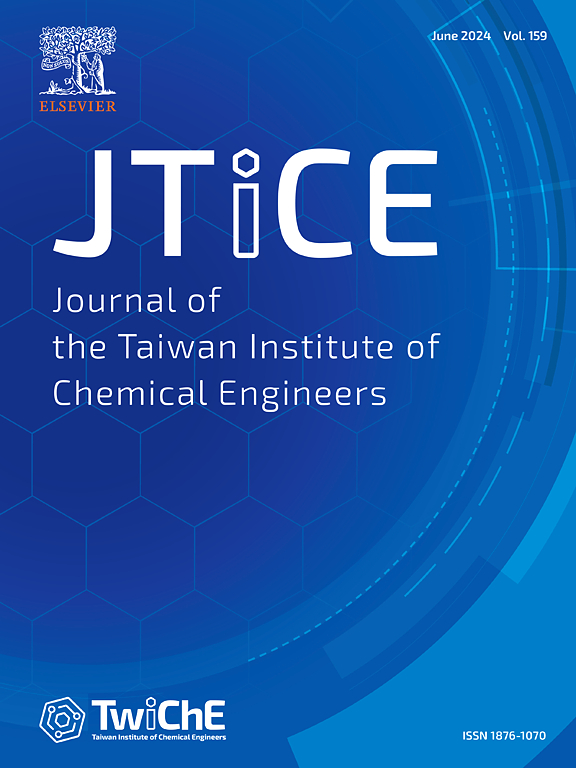Photodegradation of tetracycline and coupling photocatalytic H2O2 production driven by concave resins with different concavities under visible light irradiation
IF 5.5
3区 工程技术
Q1 ENGINEERING, CHEMICAL
Journal of the Taiwan Institute of Chemical Engineers
Pub Date : 2025-03-23
DOI:10.1016/j.jtice.2025.106101
引用次数: 0
Abstract
Background
The widespread presence of antibiotics in aquatic environments poses severe ecological risks due to inadequate removal in conventional wastewater treatment. This study investigates morphology-controlled concave polymer nanospheres for simultaneous tetracycline (TC) degradation and photocatalytic H2O2 production.
Methods
Synthesis of aminophenol-formaldehyde resins (APF) using 3-aminophenol (3-AP), ammonia water, and formaldehyde. Through precise acetone-mediated etching, three concave resin catalysts with distinct concavities (70–78 nm) and wall thicknesses (47–54 nm) were synthesized.
Significant findings
Systematic characterization revealed that increased wall thickness enhanced visible-light absorption (up to 700 nm), while higher concavity improved light reflection efficiency. The catalyst synthesized with 38 mL acetone demonstrated optimal H2O2 yield (168.5 mg g⁻¹), whereas the maximum TC degradation efficiency (106.57 % at 180 min) was achieved using the 32 mL acetone-etched catalyst with the deepest concavity. Mechanistic studies identified synergistic effects between light scattering geometry and charge carrier dynamics, where concave structures facilitated multi-directional photon utilization while thickened walls suppressed electron-hole recombination. This work provides new insights into morphology engineering for dual-functional photocatalytic systems in environmental remediation.

可见光下不同凹形树脂驱动四环素光降解及偶联光催化产H2O2研究
抗生素在水生环境中的广泛存在,由于在常规废水处理中去除不足,造成了严重的生态风险。本研究研究了形态控制的凹形聚合物纳米球,用于同时降解四环素和光催化生产H2O2。方法以3-氨基酚(3-AP)、氨水、甲醛为原料合成氨基酚甲醛树脂(APF)。通过丙酮介导的精确刻蚀,合成了三种凹形树脂催化剂,它们的凹形不同(70 ~ 78 nm),壁厚不同(47 ~ 54 nm)。系统表征表明,增加的壁厚增强了可见光吸收(高达700 nm),而更高的凹凸度提高了光反射效率。38毫升丙酮证明最优的催化剂合成过氧化氢产量(168.5毫克g⁻¹),而最大TC降解效率在180分钟(106.57%)是通过使用32毫升acetone-etched催化剂与最深的凹面。机理研究发现了光散射几何和载流子动力学之间的协同效应,其中凹结构促进了多向光子的利用,而加厚的壁抑制了电子-空穴复合。这项工作为双功能光催化系统在环境修复中的形态学工程提供了新的见解。
本文章由计算机程序翻译,如有差异,请以英文原文为准。
求助全文
约1分钟内获得全文
求助全文
来源期刊
CiteScore
9.10
自引率
14.00%
发文量
362
审稿时长
35 days
期刊介绍:
Journal of the Taiwan Institute of Chemical Engineers (formerly known as Journal of the Chinese Institute of Chemical Engineers) publishes original works, from fundamental principles to practical applications, in the broad field of chemical engineering with special focus on three aspects: Chemical and Biomolecular Science and Technology, Energy and Environmental Science and Technology, and Materials Science and Technology. Authors should choose for their manuscript an appropriate aspect section and a few related classifications when submitting to the journal online.

 求助内容:
求助内容: 应助结果提醒方式:
应助结果提醒方式:


